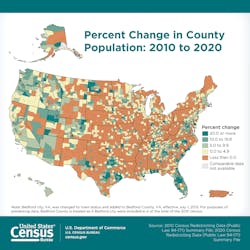Editor's Notebook: Are the New Census Numbers Good News for Transit?
The U.S. Census Bureau released data in early August to help states impacted by the ebb and flow of population shifts over the past decade begin redistricting efforts. It’s always interesting to see how the country’s population has shifted over a 10-year period, but the more information I saw, the more I found myself thinking about the various strategic plans developed at transit agencies and municipalities throughout the U.S.
The Census Bureau highlighted Los Angeles County, which remains the largest county in the U.S. with more than 10 million people. It’s also the site of my worst driving experience where it took more than four hours to travel 20 miles; an event soured further when the reverse trip the next day took 25 minutes – I have visited L.A. since, but have not driven again. Vision 2028, Los Angeles County Metropolitan Transportation Authority’s long-term strategic mobility plan, is designed to help reduce the likelihood someone else will experience something similar.
Another area of the country that seems to be at the heart of the subject is Central Florida. LYNX, the topic of this issue’s cover story, has a service area that covers three counties. Two of those counties are in the Census Bureau’s top 10 list: Osceola County for being the tenth fastest growing county based on percent change from 2010 and 2020 and Orange County for seeing the seventh largest numeric change in population from 2010 to 2020.
LYNX has conducted several studies over the years focused on transit enhancements along key corridors to improve mobility within its service area and, with local university economists estimating Central Florida’s growth will continue, those plans to enhance service now come with additional urgency.
The Census Bureau says 86 percent of the U.S. population lives in metro areas and it doesn’t take an expert to understand increased population density and masses of single occupancy cars do not make a great mix. As more of us live closer together, it may be time to revisit some of those long-term plans and move to make them reality.

Mischa Wanek-Libman | Group Editorial Director
Mischa Wanek-Libman is director of communications with Transdev North America. She has more than 20 years of experience working in the transportation industry covering construction projects, engineering challenges, transit and rail operations and best practices.
Wanek-Libman has held top editorial positions at freight rail and public transportation business-to-business publications including as editor-in-chief and editorial director of Mass Transit from 2018-2024. She has been recognized for editorial excellence through her individual work, as well as for collaborative content.
She is an active member of the American Public Transportation Association's Marketing and Communications Committee and served 14 years as a Board Observer on the National Railroad Construction and Maintenance Association (NRC) Board of Directors.
She is a graduate of Drake University in Des Moines, Iowa, where she earned a Bachelor of Arts degree in Journalism and Mass Communication.




